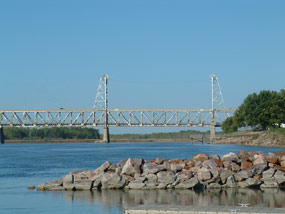 |
| Linda Gordon | | Meridian Bridge from Yankton's Riverside Park |
 |
Humans have lived along or near the "rec river" for a long time, in fact for some 10,000 years. Archeological remains of their tools and weapons, campsites and homes, foods, and religious and ceremonial objects provide clues to their lifestyles. Most of the sites have been defined by the presence of surface materials, and only limited excavations have been conducted in the area.
The Missouri River shared with the Oregon and Santa Fe trails the distinction of being one of the three main thoroughfares to the Far West. It was the great waterway of American Indians, Lewis and Clark, trappers and traders, steamboat captains, and settlers. Interaction took place between traders and Omaha and Ponca and other tribes as they traveled up and down the river. As the federal government moved the tribes to reservations, with the process overseen largely by troops at Fort Randall, land in the region became available for settlement. The 1858 Treaty between the Yankton Sioux and the federal government opened up Dakota Territory, while the Homestead Act of 1862 encouraged further immigration to the region. These settlers built a number of communities along the river corridor.
Steamboats plied the river until the late 1800s. During this time the Missouri was characterized by a constantly shifting channel, numerous smaller braided channels, chutes, sloughs, islands, sandbars, and backwater areas. The river was infamous for its sudden and dramatic shifts in course. Well over 200 steamboats are known to have sunk in the river from 1819 to 1897. At least ten of those are known to have been lost within the nearly 100 miles of the park. The wrecks now lie beneath the river's silt and sandbars.
Extensive flooding prompted the passage of many flood control measures in the mid-1900s. The one that has affected the river the most was the Flood Control Act of 1944, a part of which is the Pick-Sloan Plan. Fort Randall and Gavins Point dams, as well as the planned community of Pickstown have their origins in this Plan.
Very few of the cultural resources along the park have been studied and evaluated to determine significance in a national context. Several such properties exist close to the river in both states. The one nationally-significant historic property that can readily be seen from the river is the Meridian Bridge at Yankton.
|






